
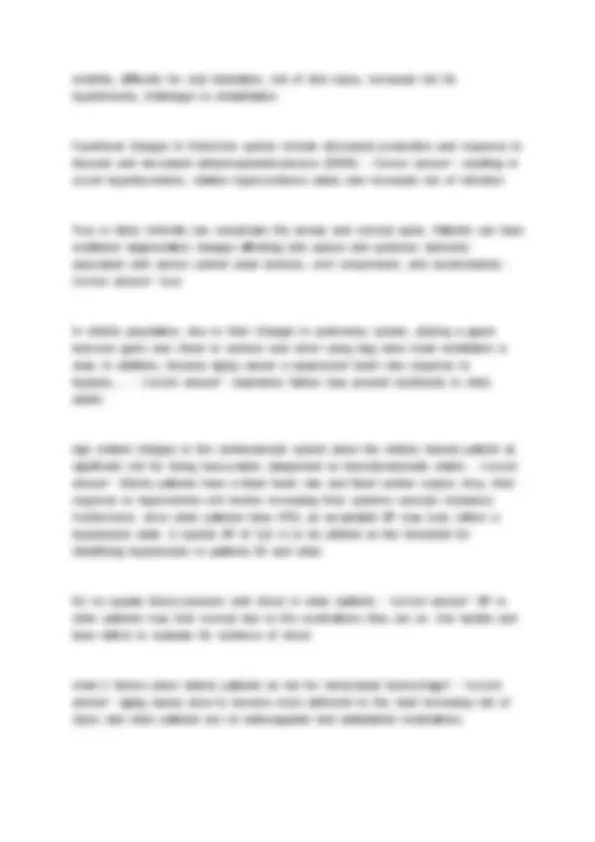
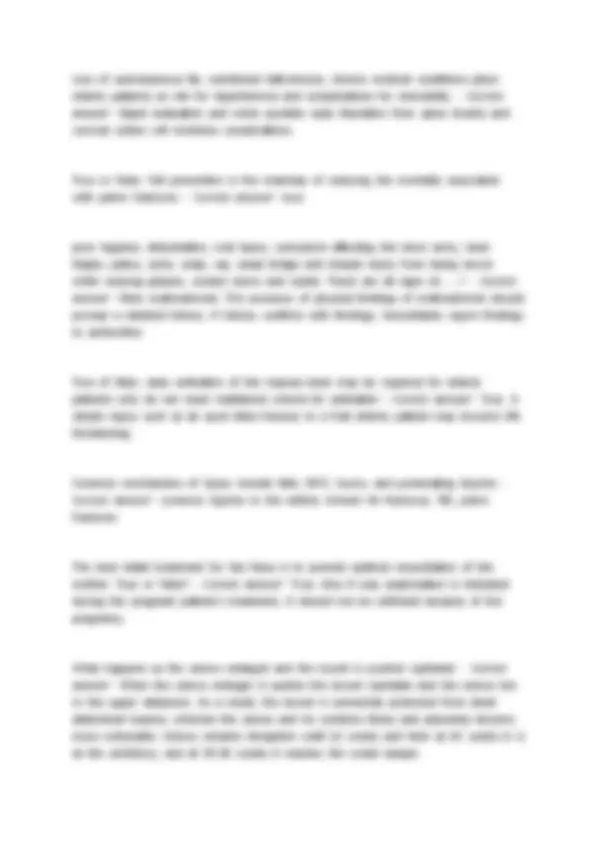
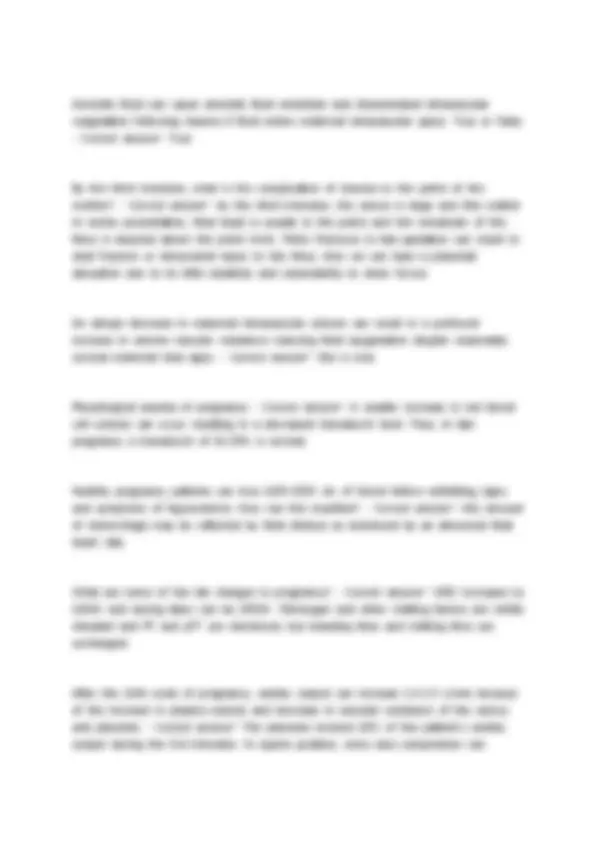

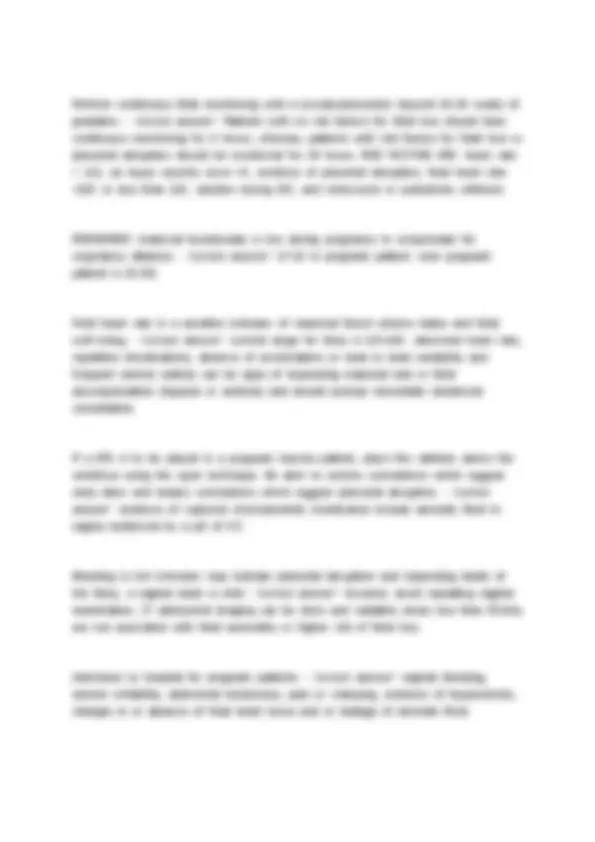

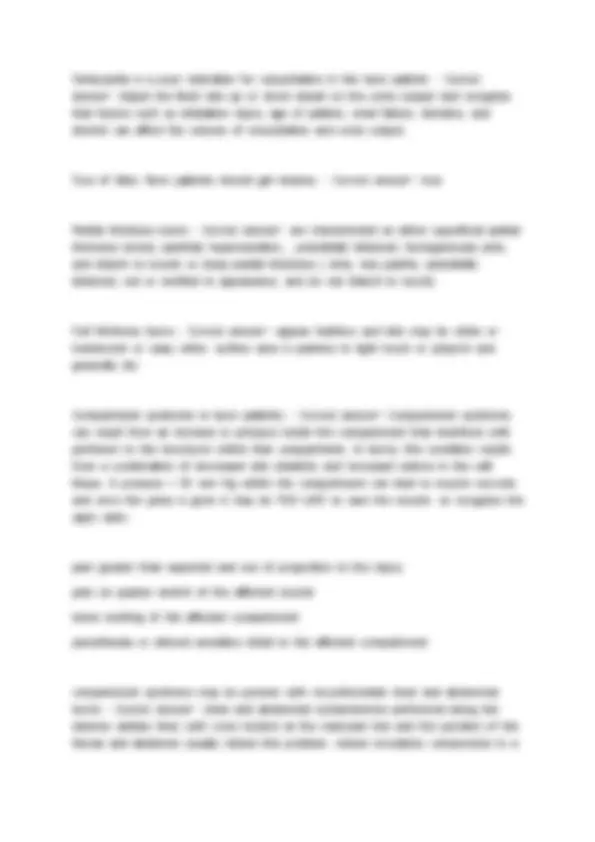

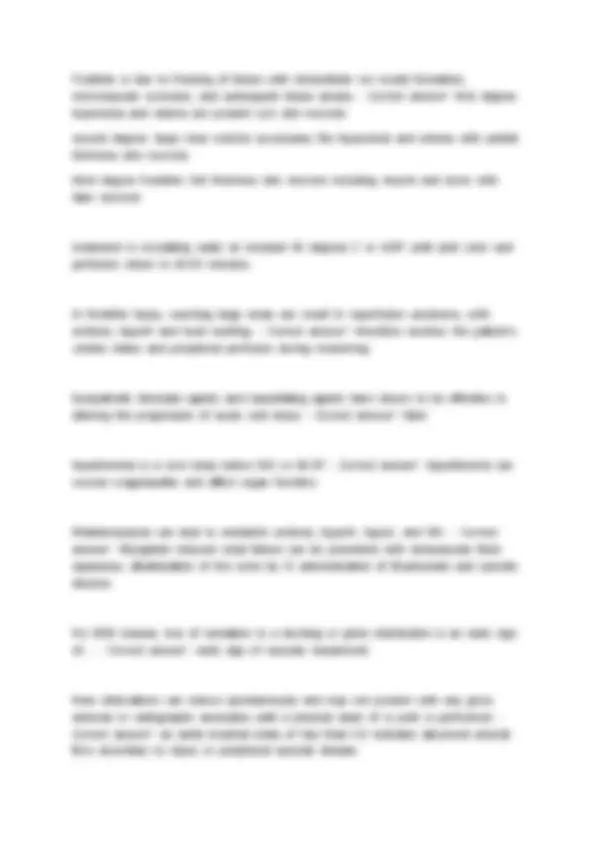



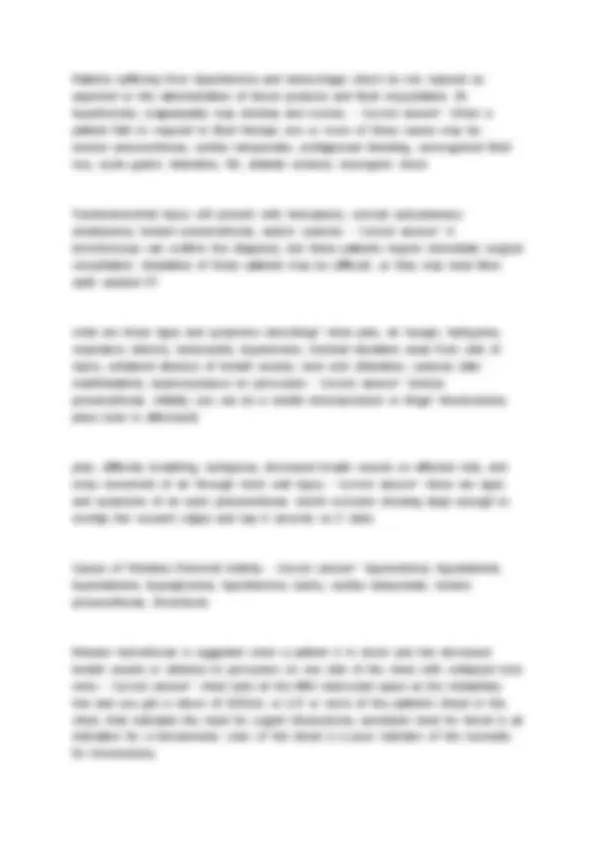
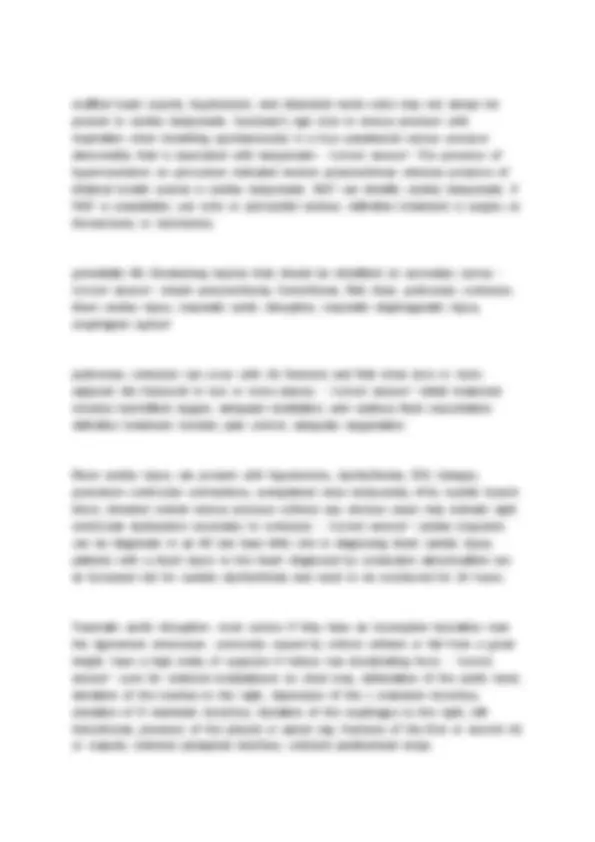
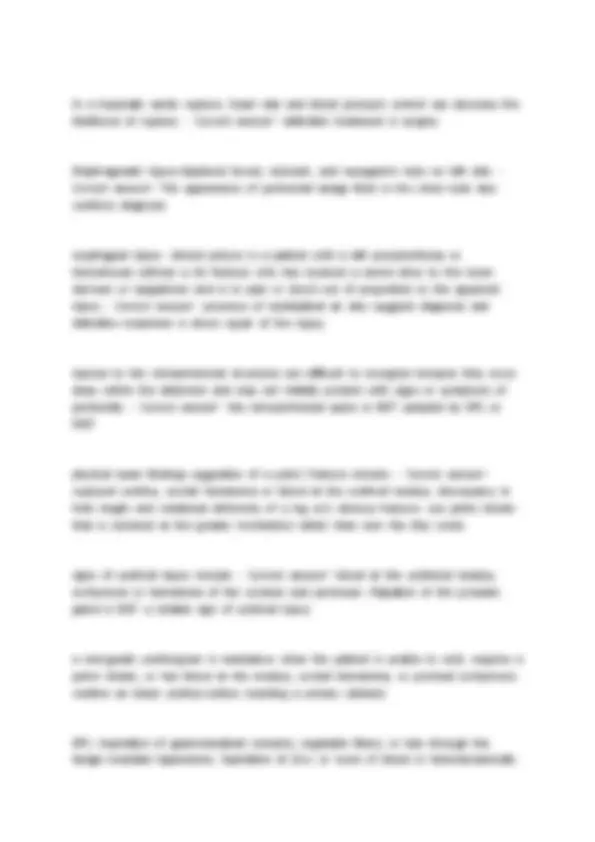



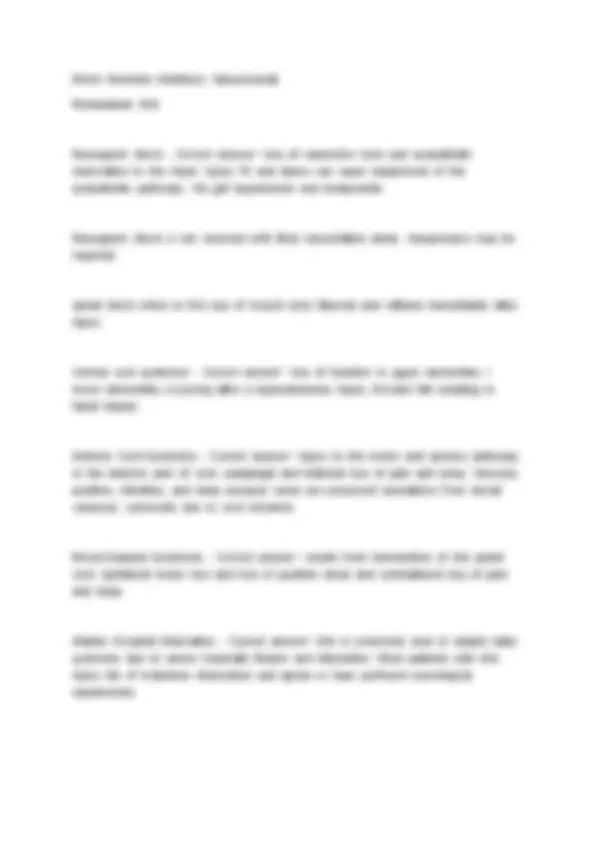



Study with the several resources on Docsity

Earn points by helping other students or get them with a premium plan


Prepare for your exams
Study with the several resources on Docsity

Earn points to download
Earn points by helping other students or get them with a premium plan
Community
Ask the community for help and clear up your study doubts
Discover the best universities in your country according to Docsity users
Free resources
Download our free guides on studying techniques, anxiety management strategies, and thesis advice from Docsity tutors
ATLS EXAM QUESTIONS AND CORRECT SOLUTIONS VERIFIED ANSWERS 100.pdf
Typology: Exams
1 / 28

This page cannot be seen from the preview
Don't miss anything!





















True or false? Although the mechanism of injury may be similar to those for the younger population, data shows increased mortality with similar severity of injury in older adults. - Correct answer~ True In the elderly population, what is decreased physiological reserve? - Correct answer~ aging is characterized by impaired adaptive and homeostatic mechanisms that caused an increased susceptibility to the stress of injury. Insults tolerated by the younger population can lead to devastating results in elderly patients. Pre-existing conditions that affect morbidity and mortality include: - Correct answer~ cirrhosis, coagulopathy, COPD, ischemic heart disease, DM What is the most common mechanism of injury in the elderly? - Correct answer~ Fall. Nonfatal falls are common in women and fractures are common in women who fall. Falls are the most common cause of TBI. In the elderly population, what are risk factors for falls? - Correct answer~ advanced age, physical impairment, history of previous fall, medication use, dementia, unsteady gait, and visual, cognitive impairment Most of elderly traffic fatalities occur in the daytime and on weekends and typically involve other vehicles. Why? - Correct answer~ Older people drive on more familiar roads and at lower speeds and tend to drive during the day. Older people have slower reaction time, a larger blind spot, limited cervical mobility, decreased hearing, and cognitive impairment.
True or False? Mortality associated with small to moderate sized burns in older adults remains high - Correct answer~ True Spilled hot liquids on the leg, which in younger patients may re-epithelialize due to an adequate number of hair follicles, will result in a full thickness burn in older patients. - Correct answer~ this is true Airway-patients may have dentures that may loosen or obstruct the airway. If dentures are not obstructing the airway, leave them in place for what? - Correct answer~ bag mask ventilation, as it improves mask fitting. When preforming rapid sequence intubation, the dose of benzos, barbiturates, and other sedatives should be reduced to what percentage to minimize the risk of cardiovascular depression? - Correct answer~ 20 - 40% Functional changes in cardiac system include declining function, decreased sensitivity to catecholamines, atherosclerosis of coronary vessels, increased afterload, fixed heart rate (beta blockers) - Correct answer~ this results in lack of classic response to hypovolemia, risk for cardiac ischemia, elevated BP at baseline, and increased risk of dysrythmias. Functional changes in pulmonary system include decreased elastic recoil, reduced residual capacity, decreased gas exchange and decreased cough reflex - Correct answer~ thus they are at increased risk for respiratory failure, increased risk for pneumonia, and poor tolerance to rib fractures Functional changes in renal system include loss of renal mass, decreased GFR, and decreased sensitivity to ADH and aldosterone - Correct answer~ resulting in drug dosing for renal insufficiency, decreased ability to concentrate urine, increased risk for AKI and urine flow may be normal with hypovolemia Functional changes to MSK include loss of lean body mass, osteoporosis, changes in joints and cartilage, c spine degenerative changes and loss of skin elastin and subcutaneous fat - Correct answer~ resulting in increased risk for fractures, decreased
Loss of subcutaneous fat, nutritional deficiencies, chronic medical conditions place elderly patients as risk for hypothermia and complications for immobility. - Correct answer~ Rapid evaluation and when possible early liberation from spine boards and cervical collars will minimize complications. True or False: Fall prevention is the mainstay of reducing the mortality associated with pelvic fractures. - Correct answer~ true poor hygiene, dehydration, oral injury, contusions affecting the inner arms, inner thighs, palms, soles, scalp, ear, nasal bridge and temple injury from being struck while wearing glasses, contact burns and scalds. These are all signs of.......? - Correct answer~ Elder maltreatment. The presence of physical findings of maltreatment should prompt a detailed history. if history conflicts with findings, immediately report findings to authorities. True of false: early activation of the trauma team may be required for elderly patients who do not meet traditional criteria for activation - Correct answer~ True. A simple injury such as an open tibia fracture in a frail elderly patient may become life threatening. Common mechanisms of injury include falls, MVC, burns, and penetrating injuries - Correct answer~ common injuries in the elderly include rib fractures, TBI, pelvic fractures The best initial treatment for the fetus is to provide optimal resuscitation of the mother. True or False? - Correct answer~ True. Also if xray examination is indicated during the pregnant patient's treatment, it should not be withheld because of the pregnancy. What happens as the uterus enlarged and the bowel is pushed cephalad. - Correct answer~ When the uterus enlarges it pushes the bowel cephalad and the uterus lies in the upper abdomen. As a result, the bowel is somewhat protected from blunt abdominal trauma, whereas the uterus and its contents (fetus and placenta) become more vulnerable. Uterus remains intrapelvic until 12 weeks and then at 20 weeks it is at the umbilicus, and at 34 - 36 weeks it reaches the costal margin.
Amniotic fluid can cause amniotic fluid embolism and disseminated intravascular coagulation following trauma if fluid enters maternal intravascular space. True or False
Urinary system: what happens to the GFR, serum creatinine and urea nitrogen levels?
AND to optimize outcomes for mother and baby, clinicians must assess and resuscitate the mother first and then assess the fetus before conducting second survey of the mother. Failure to displace the uterus to the left side in a hypotensive pregnant patient - Correct answer~ logroll all patients appearing clinically pregnant (second and third trimester) to the left 15 - 30 degrees and elevate the right side 4 - 6 inches and support with a bolstering device to maintain spinal motion restriction and decompression of the vena cava. Due to increases intravascular volume, pregnant patients can lose a significant amount of blood before tachycardia, hypotension, and other signs of hypovolemia occur. Thus, what do stable vital signs in a pregnant patient indicate about the fetus? - Correct answer~ The fetus may be in distress and the placenta deprived of vital perfusion while the mother's condition and vital signs appear stable. Administer crystalloid fluid resuscitation and blood to support the physiological hypervolemia of pregnancy. vasopressers should be an absolute last resort in restoring maternal blood pressure as they further reduce uterine blood flow, resulting in fetal hypoxia. What does a normal fibrinogen level indicate in a pregnant patient? - Correct answer~ Fibrinogen level may double in late pregnancy and a normal level may indicate early disseminated intravascular coagulation Most common cause of fetal death? - Correct answer~ maternal shock and maternal death. Placental abruption is second. Placental abruption is suggested by vaginal bleeding, uterine tenderness, frequent uterine contractions, uterine tetany, and uterine irritability (uterus contracts when touched). In 30% of cases of abruption, bleeding may not occur. Uterine ultrasound may be helpful in diagnosis, but is NOT definitive. Signs of uterine rupture - Correct answer~ abdominal tenderness, guarding, rigidity, or rebound tenderness. Signs of peritonitis are hard to tell due to expansion and attenuation of the abdominal wall musculature. Other findings include abdominal fetal lie (oblique or transverse lie), easy palpation of the fetal parts because of their extrauterine location and inability to readily palpate the uterine fundus when there is fundal rupture. Xray evidence of rupture include extended fetal extremities, abnormal fetal position, and free intraperitoneal air.
With extensive placental separation or amniotic fluid embolization, widespread consumptive coagulopathy can emerge rapidly causing depletion of fibrinogen, other clotting factors, and platelets. - Correct answer~ immediately perform uterine evacuation and replace platelets, fibrinogen, and other clotting factors. As little as 0.01mL of RH+ blood will sensitize 70% of Rh- women. - Correct answer~ All pregnany RH negative trauma patients should receive RH immunoglobulin therapy unless injury is remote from the uterus (isolated distal extremity injury) Intimate partner violence in pregnant patient: - Correct answer~ injuries inconsistent with history, diminished self image, depression or suicide attempts, self abuse, frequent ED visits, symptoms suggestive of substance abuse, isolated injuries to the gravid abdomen, parter insists on being present for the interview and exam and monopolizes discussion What is the difference between burns and other injuries? - Correct answer~ The biggest difference is that the consequences of burn injury are directly linked to the extent of the inflammatory response to the injury. The larger and deeper the burn, the worse the inflammation. Flame injury is more evident than most chemical injuries. - Correct answer~ Monitor IV lines closely to ensure they do not become dislodged as the patient becomes more edematous. Regularly check ties securing ET or NG to ensure they are not too tight. Factors that increase the risk of upper airway obstruction are: - Correct answer~ increasing burn size and depth, burns to the head and face, inhalation injury, associated trauma, and burns inside the mouth. Airway can become obstructed form direct injury such as inhalation injury, but also from massive edema resulting from burn injury. How do you decontaminate burn areas? - Correct answer~ Completely remove the patient's clothing to stop burning process, but do not peel off adherent clothing. Synthetic fabrics can ignite, burn rapidly at high temps and melt into hot residue that continues to burn the patient. brush any dry chemical powder from wound. rinse
with copious amounts of warm saline irrigation or rinsing in a warm shower. once the burning process has been stopped, cover the patient with warm, clean, dry linens to prevent hypothermia. hoarseness, stridor, accessory respiratory muscle use, sternal retraction are signs of what? - Correct answer~ airway obstruction. Clinical manifestations of inhalation injury may be subtle and may not show up within the first 24 hours. do not wait for the xray to show evidence of pulmonary injury or changes in blood gas because airway edema can preclude intubation and a surgical airway will be required. A carboxyhemoglobin level greater than what percentage indicates a patient was involved in a fire and has inhalation injury? - Correct answer~ 10% Indications for early intubation in burn patients: - Correct answer~ full thickness circumferential neck burns, signs of airway obstruction, extent of the burn > 40%, burns inside the mouth, difficulty clearing secretions or swallowing, decreased level of consciousness, Patient with inhalation injury are at risk for bronchial obstruction from secretions and debris and they may require bronchoscopy. - Correct answer~ Make sure to place an adequately sized airway tube Direct thermal injury to the lower airway is very rare and essentially occurs only after exposure to superheated steam or ignition of inhaled inflammable gases. Breathing concerns arise from what 3 general causes: - Correct answer~ hypoxia, carbon monoxide poisoning, and smoke inhalation injury. Always assume CO exposure in patients who were burned in enclosed areas. Patients with CO levels less than 20% may not show any symptoms - Correct answer~ HA and nausea (20-30%), confusion (30-40%), coma (40-60%) and death (>60%). Cherry red skin color in patients may only be seen in moribund patients. Measurements of arterial PaO2 do not reliably predict CO poisoning b/c a partial pressure of only 1 mm Hg results in an HbCO level of 40% or greater. Pulse ox
Tachycardia is a poor indication for resuscitation in the burn patient. - Correct answer~ Adjust the fluid rate up or down based on the urine output and recognize that factors such as inhalation injury, age of patient, renal failure, diuretics, and alcohol can affect the volume of resuscitation and urine output. True of false: Burn patients should get tetanus. - Correct answer~ true Partial thickness burns - Correct answer~ are characterized as either superficial partial thickness (moist, painfully hypersensitive, , potentially blistered, homogenously pink, and blanch to touch) or deep partial thickness ( drier, less painful, potentially blistered, red or mottled in appearance, and do not blanch to touch) Full thickness burns - Correct answer~ appear leathery and skin may be white or translucent or waxy white. surface area is painless to light touch or pinprick and generally dry Compartment syndrome in burn patients: - Correct answer~ Compartment syndrome can result from an increase in pressure inside the compartment that interferes with perfusion to the structures within that compartment. In burns, this condition results from a combination of decreased skin elasticity and increased edema in the soft tissue. A pressure > 30 mm Hg within the compartment can lead to muscle necrosis and once the pulse is gone it may be TOO LATE to save the muscle. so recognize the signs early: pain greater than expected and out of proportion to the injury pain on passive stretch of the affected muscle tense swelling of the affected compartment paresthesias or altered sensation distal to the affected compartment compartment syndrome may be present with circumferential chest and abdominal burns - Correct answer~ chest and abdominal escharotomies performed along the anterior axillary lines with cross incision at the clavicular line and the junction of the thorax and abdomen usually relieve this problem. relieve circulatory compromise in a
circumferentially burned limb by eschartomy and these escharotimies are not needed within the first 6 hours. Partial thickness burns are painful when air currents pass over the burned surface. - Correct answer~ gently cover the burn with clean sheets will decrease the pain and deflect air currents. Do not break blisters or apply an antiseptic and application of cold compress can cause hypothermia. DO not apply cold water to a burn patient. electrical burns are more serious than they appear on the body surface and extremities, particularly the digits. - Correct answer~ current can travel inside blood vessels and nerves and can cause local thrombosis and nerve injury. So a severe electrical injury usually results in contracture of the affected extremity. A clenched hand with a small electrical entrance wound should alert the clinician that a deep soft tissue injury is likely much more extensive than is visable to the naked eye - Correct answer~ true. patients with severe electrical injuries require fasciotomies. Electricity can cause forced contraction of muscles, doctors need to examine patient for skeletal and muscular damage, especially for fractures of the spine and rhabdomyolysis How do you dissolve a tar burn? - Correct answer~ Use mineral oil Abuse and burns - Correct answer~ circular burns and burns with clear edges and unique patterns may reflect cigarette burns or iron. Burns on the sole of the feet usually suggest child was placed in hot water. A burn on the posterior aspect of the LE and buttocks Patient with electrical burn can develop for acute renal failure - Correct answer~ remember these burns can cause serious muscle damage without showing signs outright. Test urine for hemochromogen and administer proper volume. Assess for compartment syndrome and attach EKG leads as electrical injury can cause arrhythmias.
Blanched skin associated with fractures and dislocations can lead to soft tissue necrosis. The purpose of promptly reducing this injury is to prevent pressure necrosis of the lateral left ankle soft tissue - Correct answer~ the only reason to forgo an xray exam before treating a dislocation or fracture is the presence of vascular compromise or impending skin breakdown, often seen with fracture dislocations of the ankle Treat all patients with open fractures as soon as possible with iv antibiotics - Correct answer~ cephalosporins are necessary for all open fractures operative revascularization to an avascular extremity is important to treat emergently.
the lower the systemic pressure, the lower the compartment pressure that causes compartment syndrome risk of tetanus: - Correct answer~ wounds that are more than 6 hours old contused or abraded more than 1cm in depth from high velocity missiles due to burns or cold significantly contaminated ischemic tissue or denervated wounds True or false? on page 162. To exclude occult dislocation and concomitant injury, x ray films must include the joints above and below the suspected fracture site - Correct answer~ true. unless life threatening, splinting of extremity injuries should be done during the secondary survey. do not apply traction to patients with an ipsilateral tibia shaft fracture. - Correct answer~ true Laryngeal Trauma presents as hoarseness, subcutaneous emphysema, and palpable fracture - Correct answer~ true. sounds of airway obstruction and include snoring, gurgling, stridor, hoarseness, cyanosis, agitation LEMON assessment for difficult airway - Correct answer~ Look, evaluate 3 - 3 - 2 rule, mallampati, obstruction, neck mobility Do not give a nasopharyngeal airway to someone suspected of having a cribriform plate fracture. - Correct answer~ also do not give nasotracheal intubation to patients with basillar skull fracture
tachycardia is diagnosed as > 100 in adults
160 in infants 140 in preschool aged children 120 in children from school age to puberty. Tachycardia, muffled heart sounds, dilated engorged neck veins, hypotension and insufficient response to fluid therapy is what? - Correct answer~ cardiac tamponade, which is commonly caused by penetrating thoracic trauma, but can result from blunt injury to the thorax. Definitive treatment is operative intervention as pericardiocentesis is temporary measure. Tension pneumothorax differs because it presents with distended neck veins and hypotension as well as absent breath sounds and hyperresonant percussion Acute respiratory distress, subcutaneous emphysema, absent unilateral breath sounds, hyperresonance to percussion, and tracheal shift supports the diagnosis of???? - Correct answer~ tension pneumothorax. needle or finger decompression temporarily relieves this life threatening condition and follow this with a chest tube isolated intracranial injuries do not cause shock, unless the brainstem is injured. A narrowed pulse pressure is not seen in neurogenic shock. - Correct answer~ The classic presentation of neurogenic shock is hypotension (due to loss of sympathetic tone) without tachycardia. A narrowed pulse pressure is not seen in neurogenic shock. The failure of fluid resuscitation to restore organ perfusion and tissue
oxygenation suggest either continuing hemorrhage or neurogenic shock Less than 15% blood loss. no change in HR, BP, pulse pressure, RR, urine output. - Correct answer~ this is class 1 hemorrhage and requires monitoring with base deficit of 0 - - 2 15 - 30% blood loss. increase in heart rate. decrease in pulse pressure. BP, RR, urine output do not change - Correct answer~ class II hemorrhagic shock. possible need for blood products, but mostly crystalloid fluid and base deficit of - 2 to - 6. anxiety, fear
31 - 40% blood loss. heart rate increase, respiratory rate increase, blood pressure decrease, pulse pressure decrease, urine output and GCS decrease - Correct answer~ class III and this is the least amount of blood loss that consistently causes a drop in systolic blood pressure. blood products needed and base deficit is - 6 to - 10
40% blood loss. heart rate increase, RR increase, BP decrease, pulse pressure decrease, urine output and GCS decrease - Correct answer~ MTP and base deficit is - 10 or less A chest xray must be obtained after attempts at inserting a subclavian or IJ to document position of line and evaluate for pneumo or hemothorax. - Correct answer~ do not use sodium bicarb to treat metabolic acidosis from hypovolemic shock Hypothermia can be prevented and reversed by storing crystalloids in a warmer or infusing them through intravenous fluid warmers. - Correct answer~ blood products cannot be store in a warmer, but they can be heated by passage through intravenous fluid warmers. Fluids should be warmed to 39C or 102.2F before infusing them. Massive fluid resuscitation with the resultant dilution of platelets and clotting factors (severe hemorrhage and injury results in consumption of coagulation factors and early coagulopathy) contributes to coagulopathy in injured patients. - Correct answer~ The response of elderly patients, athletes, pregnant patients, patients on medications, hypothermic patients, and patients with pacemakers or implantable devices may have different set of vitals in response to shock. Older patients are unable to increase their HR when stressed by blood volume loss. A systolic BP of 100 may represent shock in an elderly patient. Due to medications, HR may not increase in the elderly population when in shock. - Correct answer~ Blood volumes may increase 15 - 20% in athletes, cardiac output can increase 6 fold and the rest HR can be 50. Trained athletes have a remarkable ability to compensate for blood loss and they may not manifest the usual way to hypovolemia, even with significant blood loss.